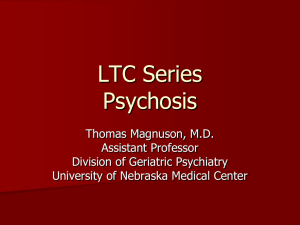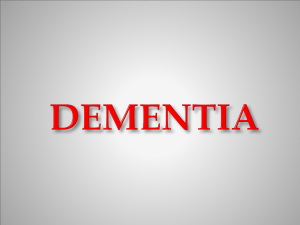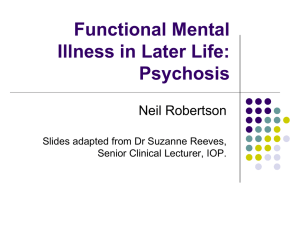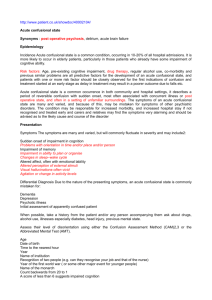David Mamo
advertisement
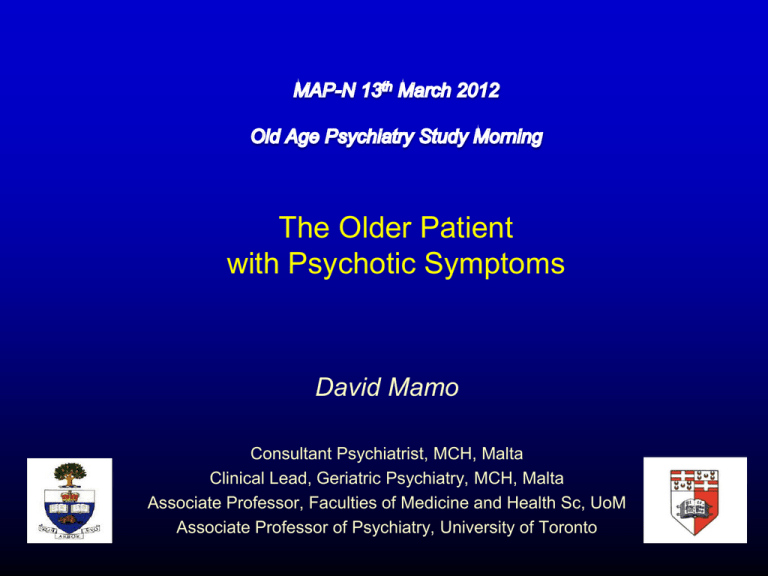
The Older Patient with Psychotic Symptoms David Mamo Consultant Psychiatrist, MCH, Malta Clinical Lead, Geriatric Psychiatry, MCH, Malta Associate Professor, Faculties of Medicine and Health Sc, UoM Associate Professor of Psychiatry, University of Toronto Learning Objectives • Be familiar with the common causes of psychosis in the elderly • Understand the importance of Secondary vs. Primary Psychotic Disorders in the Elderly • Build confidence in the systematic triage including physical and mental state examination, and initial management of a an older person presenting with psychotic symptoms • Appreciate that aging is best considered as a dynamic course than as a cross-sectional state, making psychosis in the elderly “a moving target”. • Introduce the new and evolving geriatric mental health services being developed in Malta What is Psychosis? Generally defined as “Hallucinations and Delusions” ..but, often accompanied by (a) Disorganized Thinking, and (b) Disorganized Behavior Hallucinations and Delusions ≠ Schizophrenia Can be “PRIMARY” or “SECONDARY” THERE ARE NO RELIABLE PATHOGNOMONIC SIGNS TO DISTINGUISH PRIMARY Vs. SECONDARY Therefore, one must (but especially in the ELDERLY) consider and rule out secondary causes. Primary & Secondary Psychosis Primary Psychotic Disorders (a) Schizophrenia and Related Disorders (b) Affective Psychosis Secondary Psychotic Disorders (a) Dementia: Alzheimer’s, Vascular, LBD, other dementias (b) Delirium: (I WATCH DEATH in PAIN) (c) Substance-Induced (including medication!) (d) General Medical Conditions (MINES) Etiologies of Pychosis in Older Adults (in order of frequency) 1. Alzheimer’s & other dementias 2. Depression 3. Medical / Toxin / Substance-Induced 4. Delirium 5. Bipolar Disorder 6. Delusional Disorder 7. Schizophrenia 8. Schizoaffective Disorder Differential Diagnosis of the Older Patient with Psychotic Symptoms. Manepalli et al; Primary Psychiatry, 2007. Etiologies of Pychosis in Older Adults (in order of frequency) 1. Alzheimer’s & other dementias 2. Depression 3. Medical / Toxin / Substance-Induced 4. Delirium 5. Bipolar Disorder 6. Delusional Disorder 7. Schizophrenia 8. Schizoaffective Disorder Differential Diagnosis of the Older Patient with Psychotic Symptoms. Manepalli et al; Primary Psychiatry, 2007. Psychosis: A Common Clinical Presentation in the Elderly Community: 1-4% Acute Psychogeriatric Hospital/Ward: 10% Nursing Homes: up to 60% Elderly without dementia > 85 years: 10% VERY HIGH PREVALANCE OF ANTIPSYCHOTIC USE IN NURSING HOMES Chen et al, Arch Internal Med, 2010 Psychosis: Risk Factors in the Elderly 1. 2. 3. 4. 5. Sensory Deficits Social Isolation Cognitive Decline Medical Comorbidities Polypharmacy Case 1: Psychosis – The Great Chameleon Case 1: As your community’s psychogeriatric resource nurse, you are asked to call on Mrs. Borg, a 92 year old widowed lady with no past medical or psychiatric history living on her own with some support from a home help worker 1 hour per day. You are told that she has been acting strangely over the past few months, talking of little people visiting her at night and observing unusual images on her walls. You are told that her memory has declined over the past few months and needs support in most iADL’s but is independent of ADL’s. At this time your primary/working diagnosis is: A. Late-Onset Schizophrenia B. Psychosis Secondary to a Medical Illness C. Dementia D. Depression with Psychotic Symptoms E. Boredom of Old Age Case 1: As your community’s psychogeriatric resource nurse, you are asked to call on Mrs. Borg, a 92 year old widowed lady with no past medical or psychiatric history living on her own with some support from a home help worker 1 hour per day. You are told that she has been acting strangely over the past few months, talking of little people visiting her at night and observing unusual images on her walls. You are told that her memory has declined over the past few months and needs support in most iADL’s but is independent of ADL’s. At this time your primary/working diagnosis is: A. Late-Onset Schizophrenia B. Psychosis Secondary to a Medical Illness C. Dementia D. Depression with Psychotic Symptoms E. Boredom of Old Age Case 1 continued: The most critical aspect of your assessment of Mrs. Borg involves: A. Obtaining detailed history from reliable informant B. Establish Personal and Developmental History C. Checking her Vital Signs and Doing a MMSE D. Rule out Schizophrenia E. A & C F. All the Above Case 1 continued: The most critical aspect of your assessment of Mrs. Borg involves: A. Obtaining detailed history from reliable informant B. Establish Personal and Developmental History C. Checking her Vital Signs and Doing a MMSE D. Rule out Schizophrenia E. A & C F. All the Above Case 1 continued: Having established your provisional diagnosis, you consider your next step. As a thorough clinician accustomed to deal with severe mental illness and trained to maintain calm and use emergency resources carefully given current constraints on emergency medical resources and hospital beds, you decide to: A. Arrange an urgent Crisis Team Appointment the Next Day B. Arrange Appointment at POP next week and involve Outreach Services in the Meanwhile C. Inform your supervisor and document your discussion D. Counsel the Caregiver about Dementia B. None of the Above Case 1 continued: Having established your provisional diagnosis, you consider your next step. As a thorough clinician accustomed to deal with severe mental illness and trained to maintain calm and use emergency resources carefully given current constraints on emergency medical resources and hospital beds, you decide to: A. Arrange an urgent Crisis Team Appointment the Next Day B. Arrange Appointment at POP next week and involve Outreach Services in the Meanwhile C. Inform your supervisor and document your discussion D. Counsel the Caregiver about Dementia B. None of the Above Medical Causes of Psychosis with or without delirium (MINES) Metabolic B12 and Folate Def Electrolyte Abnormalities Infections Encephalitis Meningitis Syphilis HIV Neurologic Parkinson’s, Epilepsy, Strokes, Subdural hematomas, huntington’s, tumor. Endocrine Thyroid, Parathyroid, Adrenal, hyperand hypo- glycemia. Substances Intoxication or Withdrawal Benzodiazepines, Alcohol Narcotics, Anticholinergics, Case 2: The Hidden Pain Case 2: As the local psychogeriatric resource nurse, you are called on a 70 year old man recently admitted to a nursing home who has recently been getting increasingly intermittently agitated, pacing the halls all day, and getting very confused, paranoid, and physically abusive at night. You learn that he has been recently discharged from your local rehab facility where he was treated for a urinary tract infection. You are told that he suffers from hypertension which has been managed with medication, and a history of dementia, but you note that his recent discharge summary does not indicate a diagnosis of dementia, and that he was previously living fairly independently at his own home. You find the patient seated in a chair. He is very pleasant, but fidgety. He starts a conversation about his past involvement with a local soccer team, and you are impressed by how articulate he is. Yet, he is also very distractible, often loosing track of the conversation. You conduct an MMSE scoring 21/30, yet his clock drawing is surprisingly good. His vitals reveal a pulse rate of 110 bpm, and BP 145/90. He appears uncomfortable but is unable to tell you why. Your plan involves: A. Getting a verbal order for risperidone 1 mg stat B. Counsel the staff about the management of BPSD C. Arrange for a physical examination to be done Case 2: As the local psychogeriatric resource nurse, you are called on a 70 year old man recently admitted to a nursing home who has recently been getting increasingly intermittently agitated, pacing the halls all day, and getting very confused and verbally abusive at night. You learn that he has been recently discharged from your local rehab facility where he was treated for a urinary tract infection. You are told that he suffers from hypertension which has been managed with medication, and a history of dementia, but you note that his recent discharge summary does not indicate a diagnosis of dementia, and that he was previously living fairly independently at his own home. You find the patient seated in a chair. He is very pleasant, but fidgety. He starts a conversation about his past involvement with a local soccer team, and you are impressed by how articulate he is. Yet, he is also very distractible, often loosing track of the conversation. You conduct an MMSE scoring 21/30, yet his clock drawing is surprisingly good. His vitals reveal a pulse rate of 110 bpm, and BP 145/90. He appears uncomfortable but is unable to tell you why. Your plan involves: A. Getting a verbal order for risperidone 1 mg stat B. Counsel the staff about the management of BPSD C. Arrange for a physical examination to be done Delirium • A sudden and significant decline in mental functioning not better accounted for by a preexisting or evolving dementia • Disturbance of consciousness with reduced ability to focus, sustain, and shift attention 4 major causes • • • • Underlying medical condition Substance intoxication Substance withdrawal Combination of any or all of these Causes of Delirium (I WATCH DEATH) Infections Deficiencies Withdrawals Endocrinopathies Acute Metabolic Acute Vascular Trauma Toxins or Drugs CNS Pathology Heavy Metals Hypoxia Causes of Delirium (I WATCH DEATH PAIN) Infections Deficiencies Withdrawals Endocrinopathies Acute Metabolic Acute Vascular Trauma Toxins or Drugs CNS Pathology Heavy Metals Hypoxia PAIN Prevalence • Hospitalized medically ill: 10-30% • Hospitalized elderly: 10-40% • Postoperative patients: up to 50% • Near-death terminal patients: up to 80% Clinical features Prodrome Fluctuating course Attentional deficits Arousal /psychomotor disturbance Impaired cognition Sleep-wake disturbance Altered perceptions Affective disturbances Beware of the “quiet” delirium… • Hyperactive (agitated, hyperalert) • Hypoactive (lethargic, hypoalert) • Mixed Outcome • Elderly patients 22-76% chance of dying during that hospitalization • Several studies suggest that up to 25% of all patients with delirium die within 6 months Management • Environmental interventions - “Timelessness” - Sensory impairment (vision, hearing) - Orientation cues - Family members - Frequent reorientation - Nightlights Management • Pharmacologic management of agitation - Low doses of high potency neuroleptics (i.e. haloperidol) – po, im or iv - Atypical antipsychotics (risperidone) Benzodiazepines generally restricted to withdrawal situations as they may cause paradoxical reactions Case 3: Je Me Souviens Case 3: An 81 year old man has been seeing his dead wife and dead sister for the past three months. He has a 4 year history of declining memory and difficulties with iADL’s. His daughter reminds you that he has a history of recurrent bouts of depression, and you note that he has been crying and having difficulty sleeping, and calling her incessantly and getting very anxious when she is about to leave. You are a seasoned nurse and recognize the importance of a physical and cognitive evaluation in such situations, and note that his BP is 165/90, PR normal, afebrile, but appears mildly rigid in his upper and lower extremities, and he shuffles somewhat when he walks. MMSE is 17/30, and his attention span during your assessment is excellent. His daughter shows you results from recent tests done in hospital stating that his CT brain was unremarkable except for mild atrophy The most likely explanation of this presentation is: A. Parkinson’s Disease with Dementia B.Severe Depression with Psychotic Symptoms C.Alzheimer’s Disease D.Late-Onset Schizophrenia E.Lewy-Body Dementia Case 3: An 81 year old man has been seeing his dead wife and dead sister for the past three months. He has a 4 year history of declining memory and difficulties with iADL’s. His daughter reminds you that he has a history of recurrent bouts of depression, and you note that he has been crying and having difficulty sleeping, and calling her incessantly and getting very anxious when she is about to leave. You are a seasoned nurse and recognize the importance of a physical and cognitive evaluation in such situations, and note that his BP is 165/90, PR normal, afebrile, but appears mildly rigid in his upper and lower extremities, and he shuffles somewhat when he walks. MMSE is 17/30, and his attention span during your assessment is excellent. His daughter shows you results from recent tests done in hospital stating that his CT brain was unremarkable except for mild atrophy The most likely explanation of this presentation is: A. Parkinson’s Disease with Dementia B.Severe Depression with Psychotic Symptoms C.Alzheimer’s Disease D.Late-Onset Schizophrenia E.Lewy-Body Dementia Psychosis in Alzheimer’s Dementia Very Common (20% in Early; 50% by Years 3 & 4) Most Common in Early to Moderate Stages Delusions and/or Hallucinations Hallucinations (Visual > auditory > others) Delusions (Commonly “understandable” false beliefs – e.g. delusions of theft, house is not home, persecution); these decrease in later stages. ? Psychosis associated with more rapid decline http://www.alzheimers.org.uk ‘Management of Behavioural Changes in Individuals with Dementia’ by Dr Carmelo Aquilina Wednesday 14th March 2012 Time: 6:30pm-7:30pm Venue: 5, Lion Street, Floriana Case 4: Slow, Unsteady, and Scared Case 4: A 75 year old woman reports hallucinations of children and small animals when she is alone in her room. Her family describe her getting very agitated when this happens. On your functional inquiry they respond that she has been having more difficulty walking, and at times has some tremor in her hands. Aware that dementia is a a very common cause of hallucinations in the elderly, you inquire about her memory. Her daughter acknowledges that she noted a small but noticeable decline in recent memory over the past year, with a tendency to repeat questions, difficulties with finding the right words, getting lost when shopping, and preparing meals. The daughter also noticed that her state tends to fluctuate somewhat, having some “good days” in which she seems quite well in terms of her memory and even her tremor. Your examination is unremarkable except for some rigidity in her arms and mild resting tremor. The most likely explanation of this presentation is: A. Parkinson’s Disease with Dementia B.Severe Depression with Psychotic Symptoms C.Alzheimer’s Disease D.Late-Onset Schizophrenia E.Lewy-Body Dementia Case 4: A 75 year old woman reports hallucinations of children and small animals when she is alone in her room. Her family describe her getting very agitated when this happens. On your functional inquiry they respond that she has been having more difficulty walking, and at times has some tremor in her hands. Aware that dementia is a a very common cause of hallucinations in the elderly, you inquire about her memory. Her daughter acknowledges that she noted a small but noticeable decline in recent memory over the past year, with a tendency to repeat questions, difficulties with finding the right words, getting lost when shopping, and preparing meals. The daughter also noticed that her state tends to fluctuate somewhat, having some “good days” in which she seems quite well in terms of her memory and even her tremor. Your examination is unremarkable except for some rigidity in her arms and mild resting tremor. The most likely explanation of this presentation is: A. Parkinson’s Disease with Dementia B.Severe Depression with Psychotic Symptoms C.Alzheimer’s Disease D.Late-Onset Schizophrenia E.Lewy-Body Dementia Psychosis in Lewy Body Dementia Very Common (visual hallucinations up to 80%; often an early sign) Auditory hallucinations (20%) and paranoid delusions (65%) also common Therefore, overall at least as common (if not more) compared with psychosis in AD Important to recognize due to (a) high sensitivity to even low doses of antipsychotics (especially high potency), (b) greater risk of falls, (c) sleep disorders, (d) fluctuating and more rapid course. Psychosis in Parkinson’s Disease Also very Common (20 – 60%, more so in later stages with dementia) Hallucinations more common than delusions (often vivid visual hallucinations) Hallucinations most commonly secondary to dopaminergic medication (rather than due to PD per se). Onset of Sx vis-à-vis medication dosing times / new treatment can give clues to etiology. Case 5: The Intruder Case 5: You conduct a home visit for a a very pleasant and seemingly cognitively intact 69 year old woman who has become a local nuisance with the police and neighbors over the past 7 months, making frequent reports about “the woman next door entering” her home. She cites a number of pieces of “evidence” for her case, including lights and noises she hears at night, and a “fallen toothpick” which she placed in her key hole to check whether anyone has tried to force her door open. She has no psychiatric history, has been generally well physically except for a declining hearing and vision. You call her son from her home and he informs you that his mother was never unwell, though in hindsight she always tended to be somewhat “sensitive” and suspicious of others’ motives. He confirms that she has never abused alcohol or drugs. She has evidently been taking very good care of herself and her house, and while she has tended to avoid going out, she has no difficulty walking. On your examination you notice that except for very mild forgetfulness (MMSE 27/30) she is physically intact and her mental status is otherwise unremarkable. The most likely explanation of this presentation is: A. Bipolar Disorder B. Alzheimer’s Disease C. Delusional Disorder D. Paranoid Personality Disorder Case 5: You conduct a home visit for a a very pleasant and seemingly cognitively intact 69 year old woman who has become a local nuisance with the police and neighbors over the past 7 months, making frequent reports about “the woman next door entering” her home. She cites a number of pieces of “evidence” for her case, including lights and noises she hears at night, and a “fallen toothpick” which she placed in her key hole to check whether anyone has tried to force her door open. She has no psychiatric history, has been generally well physically except for a declining hearing and vision. You call her son from her home and he informs you that his mother was never unwell, though in hindsight she always tended to be somewhat “sensitive” and suspicious of others’ motives. He confirms that she has never abused alcohol or drugs. She has evidently been taking very good care of herself and her house, and while she has tended to avoid going out, she has no difficulty walking. On your examination you notice that except for very mild forgetfulness (MMSE 27/30) she is physically intact and her mental status is otherwise unremarkable. The most likely explanation of this presentation is: A. Bipolar Disorder B. Alzheimer’s Disease C. Delusional Disorder D. Paranoid Personality Disorder Delusional Disorder • Relatively uncommon (0.03%) but more common in older adults • Different from Schizophrenia in lack of hallucinations, absence of deterioration of function, and generally absence of disorganization of behavior and certainly of thought. • Different from Dementia in absence of Cognitive Decline • Different from Mood Disorder: No preceding mood component • Often find premorbid history of paranoid and schizotypal personalities • Difficult to manage/treat as they deny illness and refuse medication (but AP’s are effective, if taken..); CBT approaches can be helpful. Case 6: Looming Death Case 6: A previously healthy 70-year old woman is admitted to KGH for failure to thrive. She has lost 20 Kg in the past 7 months, has difficulty swallowing solids and liquids, and has lost her appetite entirely. Previously the life of her family, she no longer enjoys visits from her children, and would rather be left alone. Physical examinations, laboratory tests, imaging and endoscopy have yielded no positive results. You are part of a psychogeriatric consultation service and asked to see patient to rule out a “psychosomatic illness”. You find a cachectic woman seated in her chair. She is difficult to engage, makes little eye contact, and shows marked latency of speech. When you ask her why she is not eating she points to her throat and says that the “feeding tube is clogged”. Her affect is dysphoric but blunted in reactivity and shows very limited range. When asked what she believes is the root of her problem she indicates that she has a terminal cancer. You note that she has resigned herself to dying, and sees no scope for living any further. Mention of her large family elicits no emotion from her. Cognitively she is difficult to assess fully as her ability to focus and persist on tasks is limited. However she is clearly alert, well-oriented to exact place, and oriented to time o the year. Recent memory appears mildly impaired, though formal testing not done. The most likely explanation of this presentation is: A. Major Depressive Episode with Psychotic Symptoms B. Schizoaffective Disorder, Depressed State C. Occult Gastric Carcinoma Case 6: A previously healthy 70-year old woman is admitted to KGH for failure to thrive. She has lost 20 Kg in the past 7 months, has difficulty swallowing solids and liquids, and has lost her appetite entirely. Previously the life of her family, she no longer enjoys visits from her children, and would rather be left alone. Physical examinations, laboratory tests, imaging and endoscopy have yielded no positive results. You are part of a psychogeriatric consultation service and asked to see patient to rule out a “psychosomatic illness”. You find a cachectic woman seated in her chair. She is difficult to engage, makes little eye contact, and shows marked latency of speech. When you ask her why she is not eating she points to her throat and says that the “feeding tube is clogged”. Her affect is dysphoric but blunted in reactivity and shows very limited range. When asked what she believes is the root of her problem she indicates that she has a terminal cancer. You note that she has resigned herself to dying, and sees no scope for living any further. Mention of her large family elicits no emotion from her. Cognitively she is difficult to assess fully as her ability to focus and persist on tasks is limited. However she is clearly alert, well-oriented to exact place, and oriented to time o the year. Recent memory appears mildly impaired, though formal testing not done. The most likely explanation of this presentation is: A. Major Depressive Episode with Psychotic Symptoms B. Schizoaffective Disorder, Depressed State C. Occult Gastric Carcinoma Affective Psychosis Psychotic Depression present in up to 50% of hospitalized elderly patients with depression, and 25% of community dwelling elderly with depression Delusions (mood-congruent) much more common than hallucinations. Catatonia in severe depression Bipolar mania also generally presents with moodcongruent delusions (e.g. erotomanic) The Older Patients with Schizophrenia Schizophrenia and Aging • Rate of Cognitive Decline not different from general population (but they often start from a lower baseline and “appear” demented early!!) • Aud Halluc and Delusions may decrease • Negative Symptoms may increase • Older patients with schizophrenia have a worse functional outcome than patients with HIV-AIDS Prescribed Antipsychotic Dose and Age 1,418 patients in Tokyo Inpatients Outpatients Uchida H et al. Am J Geriatr Psychiatry (2008) Age and D2 Dean F Wong et al Uchida et al Antipsychotic Dosing Recommendations in Older Patients with Schizophrenia Up to 40 % reduction in dose > 45yrs (Harris 1997) Up to 60 % reduction in dose (mixed age) (Inderbitzin 1994; Smith 1994) Expert Consensus (Alexopoulos GS et al 2004) Risperidone 1.25 – 3.5 mg Olanzapine 7.5 – 15 mg Quetiapine 100 – 300 mg Classical pharmacokinetics does not address variability Percent Responders (CGI) LAST PIECE OF THE PUZZLE 100 80 60 Non Responders Responders 40 20 0 <65% > 65% Striatal D2 Occupancy ∆ Dose Therapeutic Window Population Pharmacokinetics Maintain Wellness “Grow old with me! The best is yet to be, the last of life, for which the first was made..” Robert Browning

